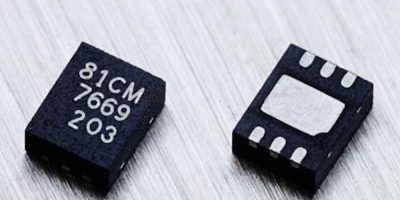For industrial and automotive applications, the MLX90381 AEC-Q100 / ISO 26262 -compliant pico-resolver is supplied in a DFN-6 package, measuring just 2.0 x 2.5mm. Only three external capacitors are required to complete the circuit.
The ASIL-ready IC is programmable at module level and enables sensored mechatronic miniaturisation, particularly in rotor position detection, said the company. Being AEC-Q100 and ISO 26262 compliant (ASIL B SEooC), also makes it suitable for automotive safety related systems.
The 3D magnetic pico-resolver has a small outline and analogue outputs providing sine and cosine signals. It uses Melexis’ Triaxis Hall technology and can be used for absolute rotary position sensing where its low latency and fast response characteristics are able to measure rotational speeds of more than 50,000 rpm.
The MLX90381 pico-resolver can be used with DC, brushless DC (BLDC) and permanent magnet synchronous motors (PMSM) in applications such as e-valves and e-bike motors.
The MLX90381 can be combined with Melexis’ family of smart embedded LIN drivers. These include the MLX81330 and MLX81332 (up to 10W) for directly driving flaps, valves and single-coil fans and pumps. It also works with the MLX81340, MLX81344 and MLX81346 pre-drivers (up to 2000W) which are incorporated into power blowers, engine cooling fans, pumps, window lifters, seat adjusters and sunroofs.
The selectable magnetic field axes (X/Y, X/Z and Z/Y) enable the MLX90381 to handle on-axis position sensing as well as off-axis through-shaft sensing. The sensitivity and filter bandwidth of each axis can be programmed directly through the device’s I2C interface. A dedicated high sensitivity version of the pico-resolver allows additional robustness against external magnetic stray fields.
The MLX90381 is available for order now.
Melexis designs, develops and delivers mixed-signal semiconductor sensor and actuator components addressing the integration of sensing, driving and communication into products and systems that improve safety, raise efficiency, support sustainability and enhance comfort.
Melexis specialises in automotive semiconductor sensors. Today, on average, every new car produced worldwide contains 13 Melexis chips, according to the company. The portfolio includes magnetic sensors, MEMS sensors (pressure, TPMS, infrared), sensor interface ICs, optoelectronic single point and linear array sensors and time of flight (ToF). The company’s driver IC portfolio incorporates advanced DC and BLDC motor controllers, LED drivers and FET pre-driver ICs.
Melexis is headquartered in Belgium.







